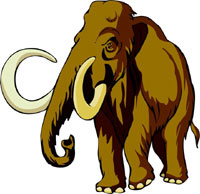
Worksheets and No Prep Teaching Resources
 Worksheets and No Prep Teaching Resources |
From Mammoths to Statehood: The History of Early Nebraska |
| edHelper's suggested reading level: | grades 4 to 6 | |
| Flesch-Kincaid grade level: | 7.45 |
| Print From Mammoths to Statehood: The History of Early Nebraska (font options, pick words for additional puzzles, and more) |
| Quickly print reading comprehension |
| Print a proofreading activity |
| Leave your feedback on From Mammoths to Statehood: The History of Early Nebraska (use this link if you found an error in the story) |
|
From Mammoths to Statehood: The History of Early Nebraska
By Gwen Wellsandt |

|
 1 Nebraska's history began millions of years ago. Geologists (scientists who study rocks) have found clues that tell what the land was like. Seashells show that Nebraska was once covered by an ocean. Fossils tell geologists that dinosaurs once lived here. The climate changed over time. During cold periods called ice ages, mammoths lived in Nebraska. They are now extinct, but so many mammoth fossils have been found that the mammoth is the state fossil.
1 Nebraska's history began millions of years ago. Geologists (scientists who study rocks) have found clues that tell what the land was like. Seashells show that Nebraska was once covered by an ocean. Fossils tell geologists that dinosaurs once lived here. The climate changed over time. During cold periods called ice ages, mammoths lived in Nebraska. They are now extinct, but so many mammoth fossils have been found that the mammoth is the state fossil. |
Create Weekly Reading Books
Prepare for an entire week at once! |